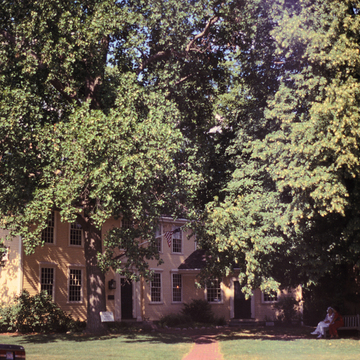Best known for its association with the battle on April 19, 1775, as the place where the Minutemen, including innkeeper John Buckman, assembled to await the arrival of British troops, Buckman Tavern is a classic example of evolutionary growth typical of surviving colonial buildings. From its beginnings about 1713 as a two-story half-house with lean-to, the building was enlarged in four successive stages before 1764 to its present four-room plan and raised hipped roof with dormer windows. The resulting Georgian-style building is illustrated in the famous Amos Doolittle prints (1775) of the battle. The Lexington Historical Society acquired Buckman Tavern in 1913, restored the interiors, and added a doorway similar to one shown in old photos. The tiny early-nineteenth-century Garrity House (9 Hancock Street) with the Federal-style carriage house adjacent are surviving members of a complex of six or more farm buildings that surrounded Buckman Tavern in the 1800s, when the property was part of the extensive Merriam Farm.
You are here
Buckman Tavern
If SAH Archipedia has been useful to you, please consider supporting it.
SAH Archipedia tells the story of the United States through its buildings, landscapes, and cities. This freely available resource empowers the public with authoritative knowledge that deepens their understanding and appreciation of the built environment. But the Society of Architectural Historians, which created SAH Archipedia with University of Virginia Press, needs your support to maintain the high-caliber research, writing, photography, cartography, editing, design, and programming that make SAH Archipedia a trusted online resource available to all who value the history of place, heritage tourism, and learning.











